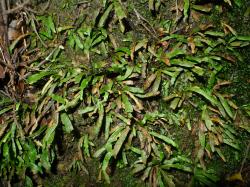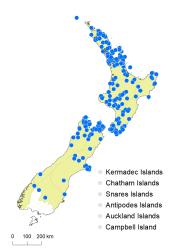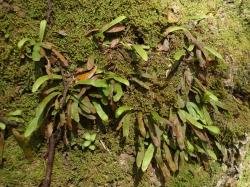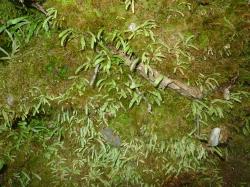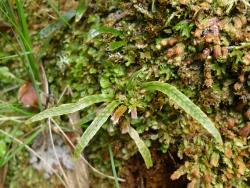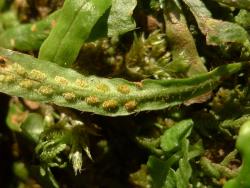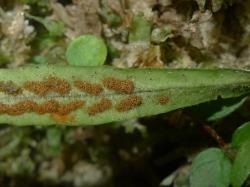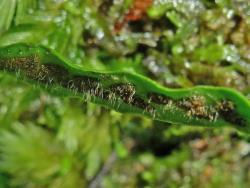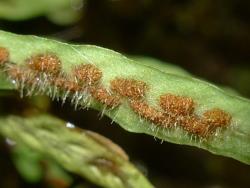- ≡ Grammitis ciliata Colenso, Tasmanian J. Nat. Sci. 2: 166 (1845)
- ≡ Polypodium australe var. ciliata (Colenso) Kirk, Trans. & Proc. New Zealand Inst. 1 (ed.2): 98 (1875)
- = Grammitis australis var. villosa Hook.f., Bot. Antarct. Voy. II (Fl. Nov.-Zel.) Part II, 44 (1854)
- ≡ Polypodium australe var. villosum (Hook.f.) Cheeseman, Man. New Zealand Fl. 1010 (1906)
- ≡ Polypodium billardierei var. villosum (Hook.f.) Cheeseman, Man. New Zealand Fl., ed. 2, 80 (1925)
- = Polypodium paradoxum Colenso, Trans. & Proc. New Zealand Inst. 14: 336 (1882)
Rhizomes erect to short-creeping, bearing scales. Rhizome scales ovate to narrowly ovate, 1.0–6.3 mm long, 0.2–1.0 mm wide, pale brown, concolorous, non-clathrate. Stipes indistinct, winged almost to base, or 1–7 mm long and 0.2–0.8 mm diameter, hairy. Stipe hairs sparse to abundant, white to pale red-brown, 0.1–1.7 mm long. Fronds undivided, linear to narrowly obovate, 9–80 mm long, very rarely to 100 mm long, 1.5–6 mm wide, rarely to 8 mm wide; apices acute; margins entire or rarely crenulate; bases attenuate to an indistinct winged stipe; both surfaces pale green; herbaceous; very rarely glabrous, usually bearing sparse to abundant hairs up to 2.1 mm long on the margin, midrib and lamina surface. Hairs either setae, or branched hairs with setiform branches. Hydathodes usually absent or rarely present. Sori subglobose to elliptic, elongated along veins, ± parallel to midrib or slightly oblique, 1–4 mm long, in 1–24 pairs in mid to upper part of lamina, bearing hairs up to 2.0 mm long, sometimes longer than lamina hairs. Sporangia 130–260 µm long; spores 16–34 µm diameter.
Notogrammitis ciliata is characterised by its erect to short-creeping rhizomes, lack of distinct stipes, small fronds (usually 9–80 mm long, 1.5–6 mm wide), fronds that are hairy throughout, and the presence of long hairs in the sori. The species is also distinguished by its habitat, which is almost always terrestrial on rocks and clay banks in lowland and montane areas. However it is very variable with respect to the abundance, length and colour of the hairs on the lamina. It can be confused with N. patagonica and N. gunnii, which have fronds bearing very similar arrangements of hairs, but they have long-creeping rhizomes, more obviously obovate fronds, and habitats that are predominantly alpine or subalpine. Notogrammitis ciliata can also be confused with N. pseudociliata, but the latter is always epiphytic and has larger fronds (22–165 mm long, 3–12 mm wide), and lamina margins that are sometimes scalloped and undulate rather than entire and flat.
North Island: Northland, Auckland, Volcanic Plateau, Gisborne, Taranaki, Southern North Island.
South Island: Western Nelson, Sounds-Nelson, Marlborough, Canterbury, Westland, Otago, Fiordland.
Three Kings Islands.
Altitudinal range: 0–1075 m.
Notogrammitis ciliata occurs in lowland to montane areas throughout the North Island, extending from the Three Kings Islands to Wellington. It grows from near sea level, reaching 1075 m in the Kaimanawa Ranges. In the South Island it is common as far south as Banks Peninsula, but there are only very scattered populations in south Canterbury, Otago and Fiordland. It ranges from 30 m, up to 860 m in the Cobb Valley, north-west Nelson.
Notogrammitis ciliata is usually a terrestrial species found under kauri, broadleaved and beech forest, and under mānuka and kānuka scrub. It grows on mossy rock faces and boulders, on clay track banks, stream banks and damp earth, on humus mounds, around roots and trunk bases, and rarely as a low epiphyte on Cyathea dealbata, Agathis australis, Phyllocladus trichomanoides and Nestegis lanceolata. It is sometimes found growing among terrestrial forest mosses such as Leucobryum.
There is evidence that Notogrammitis ciliata hybridises with N. heterophylla (AK 302263).
The count of n = 37 reported by Brownlie (1961– as Grammitis ciliata) is now known to relate to Notogrammitis patagonica (see Perrie & Parris 2012, Table 1).
No type was specified for Grammitis australis var. villosa by Hooker (1854–1855), and its synonymy with Notogrammitis ciliata is based on historical precedent first determined by Cheeseman (1906).
Perrie & Parris (2012) and Sundue et al. (2014) showed that, based on chloroplast DNA sequences, plants of N. ciliata in New Zealand are genetically polymorphic. Further work is needed to see if morphological variation is correlated with genetic variation, whether more than one species is represented in New Zealand, and whether hybrids or cryptic species are involved. Morphological variation that differs from typical N. ciliata includes plants with crenate margins and teeth to 0.5 mm long (WELT P030639), setae sometimes absent from the sori (CHR 312140, 402521 p.p.), setae absent from the lower surface of the lamina including the sori (AK 289892, Stanley s.n., Mt William), setae on abaxial surface of midrib only (AK 291078, Kawau Island; Jane s.n. to be deposited in AK), hydathodes present at vein endings on adaxial surface (CHR 312140; CHR 402521 p.p.), and the lamina of living material dark green, fleshy (Jane s.n. to be deposited in AK).



